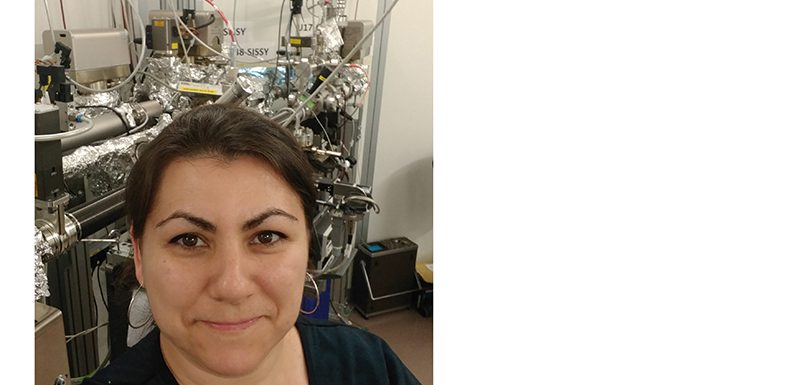
At BESSY II, we are operating some 50 beamlines, each of which offers the latest methods in spectroscopy and microscopy.
Each beamline has a dedicated beamline scientist, who not only manages all the projects on the beamline and knows its every secret, but also works with local and visiting scientists to get the best results out of the beam and its instruments for every specific research question they have. Without the beamline scientists, much of the science at BESSY II could never happen.
But who are they? What makes a good beamline scientist and where do they come from? In this little series you are going to find out. Today we introduce Dr. Mihaela Gorgoi, who works at the EMIL beamline.
What’s the name of your beamline and what’s it like?
I work at the EMIL beamline which is a very complex system. It provides light for the EMIL laboratory (Energy Materials In-situ Laboratory Berlin) by combining two undulators: UE48 for the soft X-ray range and cryo-cooled U17 for the hard X-ray range. It delivers an energy range from 80 eV to 10000 eV to five end-stations. It has ten mirror chambers to guide the light and three monochromators to select the required energies, and it has a length of 62 m while only 1 m width.
At this point I am heavily involved in the commissioning of the beamline, basically making it work. It has been a good journey and still is. My colleagues and me, we went through our share of hurdles to literally get the light through. I can’t describe the beamline in one word, because sometimes it feels larger than life to me. Even after working with it for a few years already, it still manages to positively surprise me.
For which research applications is this beamline especially suitable?
As I said before the beamline is dedicated to the EMIL laboratory. The lab was constructed as a research alliance of HZB and the Fritz-Haber Institute of the Max Planck Society. The HZB groups concentrate on studying innovative materials for energy conversion, efficiency and storage devices such as solar cells, thermoelectrics and batteries, while our partners focus on materials for catalysis.
What’s your background, scientifically? How did you get to be a beamline scientist?
I am a physicist but I am defining myself as a “modified” surface scientist :-). I wrote my PhD on the behavior of organic molecules on silicon surfaces using photoemission and inverse photoemission. During that time I also built the inverse photoemission system that I later used in my work. After that I came to Berlin to BESSY II as a station manager at HIKE, providing support to users doing hard X-ray photoemission. That is where I got involved into the workings of a beamline and I immediately loved it. After nine years, knowing that the EMIL project will combine soft and hard X-rays – a dream come true – I had the opportunity to move to one of the groups that support EMIL, and I took it. And so here I am.
What is your work as a beamline scientist?
The beamline is still in heavy commissioning right now. I am part of a team of people doing that and at the moment I am running the adjustment of the soft X-ray branches. We take decisions together on what are the exact steps required to finalize the optical alignment of the beamline. Based on that, for example I adjust a mirror to find the best position, or run a set of spectra for defining the energy resolution. These are only two points in a long list of steps required to have optimum light at the end of a beamline. It is a process that becomes more complex the more elements you have in a beamline. Our beamline is definitely on the highly complex side. This takes my entire day at present.
What is your biggest challenge in working with the beamline?
I think my biggest challenge is the interconnection of working with so many branches that share vacuum parts. I like to imagine every bit of beamline in my mind as much as I can. Every seemingly little change somewhere upstream in the beamline optics or vacuum track can result in a changed light spot or light being lost. To prevent such situations we all keep track of all motor positions for all the possible elements and we have some hundred motors or so in the entire EMIL beamline.
“There is always light at the end of the tunnel ;-), you just have to be patient enough to find it.”
What is the most rewarding part?
After going through the hurdles of good and bad during commissioning times, it is very rewarding to see the light at the focus point in one of the end-stations and find that it is as perfect as calculated by my colleagues in the Optics and Beamlines Department. And of course, what is making it even more enjoyable for me is to use that light to record a perfect proof of principle photoemission spectra.
What have you always wanted to tell people about beamline work?
There is always light at the end of the tunnel ;-), you just have to be patient enough to find it.
(kh)
